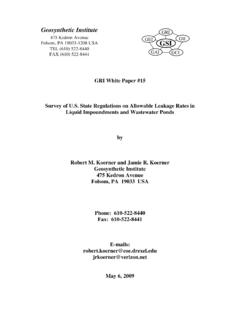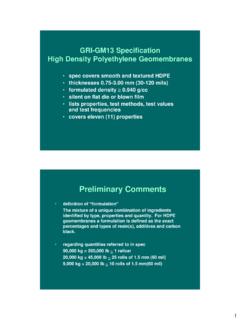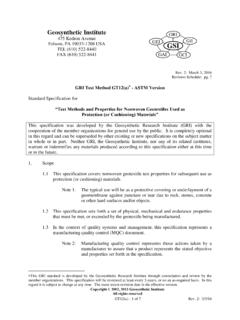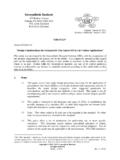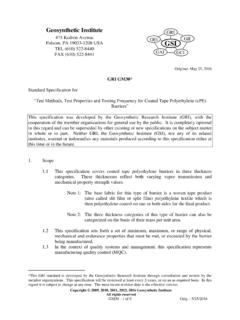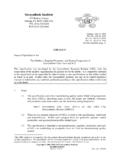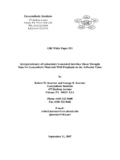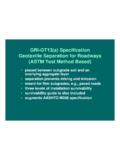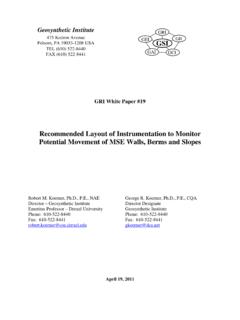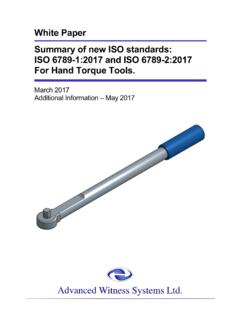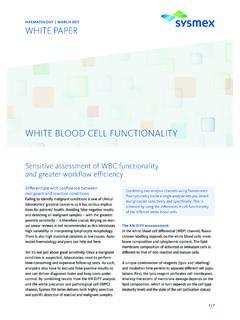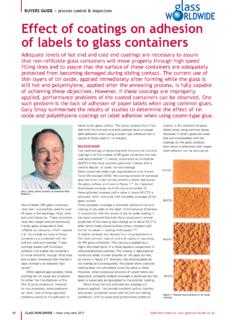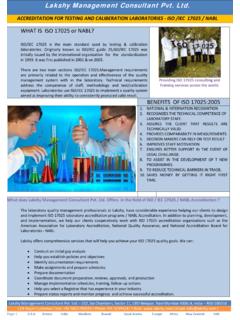Transcription of White Paper #4 - Geosynthetic Institute
1 GSI White Paper #4 Reduction Factors (RFs) Used in Geosynthetic Design Part I - Separation and Reinforcement Applications Using Geotextiles and Geogrids Part II - Filtration and Drainage Applications Using Geotextiles Part III - Drainage Applications Using Geonets, Geocomposites and Geospacers by Robert M. Koerner, , , NAE George R. Koerner, , Emeritus Professor - Drexel University Director Designate - Geosynthetic Institute Director - Geosynthetic Institute Note: This 3-part series was originally published in GFR Magazine and is reproduced in whole by permission of the magazine and its editor.
2 February 3, 2005 Revision #1, March 1, 2007 Geosynthetic Institute 475 Kedron Avenue Folsom, PA 19033-1208 USA TEL (610) 522-8440 GSI GRI GII GAI GEI GCI - 1 - GSI White Paper #4 Reduction Factors Used in Geosynthetic Design Part I - Separation and Reinforcement Applications Using Geotextiles and Geogrids Introduction to the Three-Part Series It has long been practiced that the as-manufactured properties of many geosynthetics are reduced when they are used for design purposes. In so doing, one takes an ultimate test value and modifies it into an allowable, or design, test value.
3 This practice is used in many materials and is one-half of the technique known as load and resistance factor design , or LRFD, which is used by many highway agencies. In LRFD, loads are increased and resistances are reduced so as to arrive at a conservative and safe final design. Of course, the degree of conservatism is important and often a matter of contention between the parties involved, but that issue is not addressed in this Paper . This three-part commentary is focused on the resistance aspects of geosynthetics and is presented in three board topic areas based on the primary functions that geosynthetics typically serve; they are (i) geotextiles and geogrids used in separation and reinforcement, (ii) geotextiles used in filtration and drainage, and (iii) geonets, geocomposites and geospacers used in drainage.
4 We will address separation and reinforcement in this first part, then geotextile filtration and drainage in the second part, and finally geonets, geocomposites and geospacers used in the third part. Commentary Regarding Geomembranes The concept of Reduction Factors (RF s) is to include into the measured test property of a material those influences that are not included in the test protocol, per se. A typical example as described in this White Paper is to include a RF for long-term creep into the as measured laboratory short-term test performance of the geotextile or geogrid under investigation.
5 For - 2 - materials that are adequately simulated in the test protocol there are no reduction factors (or the RF s = and thus have no effect) applied to the as-measured test properties. Such materials are steel, concrete, soil and rock. The goal in these traditional construction materials is to simulate their behavior in the laboratory test and then use the (global) factor-of-safety for unforeseen considerations in both design and testing. Geomembranes fall into this category as well.
6 The design should be such that tensile stresses do not occur, nor should short term installation damage by using proper CQC/CQA procedures or long-term damage by using appropriate protection materials (geotextiles or fine sandy soils). Lastly, long-term chemical effects are generally not a factor via the inherent inertness of most geomembranes. Under severe environmental or containment scenarios, the candidate geomembrane should be evaluated for "compatibility" per ASTM immersion and testing protocols.
7 Thus, all of the conventional reduction factors used for geotextiles and geogrids appear as s when considering geomembranes, and thus reduction factors can be eliminated from consideration in the geomembrane design process. Separation and Reinforcement Reduction Factors The usual equation for allowable strength of geosynthetics (wide-width, grab, puncture, tear, impact, etc.) is as follows. =SMCBDCRID ultallowRFRFRFRFTT1 (1) where Tallow = allowable (or design) strength, Tult = ultimate (or as-manufactured) strength, RFID = reduction factor for installation damage, RFCR = reduction factor for creep, - 3 - RFCBD = reduction factor for chemical and biological degradation, and RFSM = reduction factor for seams (if appropriate).
8 The numeric values for all of the above items are both site-specific and material-specific. The latest edition of the textbook Designing with Geosynthetics presents Table 1 for common application areas involving geotextiles and geogrids. Note that all values are listed as ranges allowing the designer considerable latitude. Commentary on each of the reduction factors follows: Table 1 - Recommended Strength Reduction Factor Values for Use in Equation 1. Range of Reduction Factors Area Installation Damage Creep* Chemical/BiologicalDegradation** Separation to to to Cushioning to to to Unpaved roads to to to Walls to to to Embankments to to to Bearing and foundations to to to Slope stabilization to to to Pavement overlays to to to Railroads to to to Flexible forms to to to Silt fences to to to *The low end of the range
9 Refers to applications which have relatively short service lifetimes and/or situations where creep deformations are not critical to the overall system performance. **Previous editions of this book have listed biological degradation as a separate reduction factor. There is no evidence, however, of such degradation for the typical polymers used to manufacture geotextiles. Thus, it is currently included with chemical degradation as a combined reduction factor. - 4 - Installation Damage - This item has been quantified in several research projects with accompanying papers that are available in the technical literature.
10 The nature of the subgrade, cover soil, and installation equipment counterpointed against the particular Geosynthetic material gives rise to the use of the lower or upper values. The option always exists to construct a test pad in the field to determine a more project-specific and precise value. Creep - Of all reduction factors to be discussed, creep has had the most attention given to it. This is appropriate since it is typically the largest value used in the calculation.
